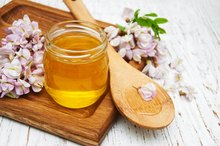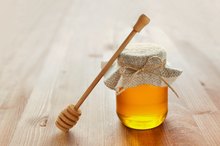What Is Raw, Unfiltered Honey?
Honey is a natural sweetener available in many forms -- from translucent liquid to thicker, creamy honey or as honeycomb, dripping with extra honey. The taste of honey changes depending on where the bees harvest the nectar used to make honey, but the processing can also affect the taste. As the least processed honey available, raw, unfiltered honey is only treated minimally.
Raw Honey Definition
According to the National Honey Board, raw honey is “as it exists in the beehive or as obtained by extraction.” Raw honey is also unstrained and does not undergo any heat processing. Commercially produced raw honey, however, often undergoes minimal processing, including high pressure filtration and gentle pasteurization. There is no current regulation for the label, so some raw honey may be more processed than others.
Honey and Filtration
What Is White Honey?
Learn More
Honey without filtration contains some impurities, including fine particles from the surrounding environment or hive, pollen grains and bubbles of air. The filtration and extraction process removes these impurities, allowing honey to stay liquid for longer, as well as giving it a clearer and more transparent appearance. All honey extracted from a hive undergoes a basic filtration by the beekeeper to remove larger solids.
Raw Honey and Pollen
Honey is made from nectar, not pollen, although some pollen particles are present in honey, especially raw honey. The National Honey Board, in a 2012 publication, found that the nutritional content of honey, including its antioxidant properties was not severely affected by processing. However, processing did significantly reduce the amount of pollen present in honey. The amount of pollen in honey is minuscule -- somewhere between 0.1 percent and 0.4 percent -- and so is considered to have no effect on the nutritional content of honey, according to Dr. Lutz Elflein, a chemist who is an expert on honey analysis.
Benefits of Raw Honey
How Effective Is Manuka Honey at Treating All Forms of Staph Infections?
Learn More
All honey can be used to treat burns, according to the University of Florida. Honey helps relieve the pain from burns, as well as prevents further air contact with the open wound, possibly reducing the risk of infection. Raw honey is also a natural anti-microbial agent, helping reduce infection as well as the symptoms of infection. A 2004 issue of the "Journal of Medicinal Food" found that an application of raw honey caused infected wounds to become less red and swollen and quickened the rate of healing, as well as the speed with which the infectious bacteria were killed. This animal study found that raw honey had the same strength and effect as local antibiotics, although the fresher the raw honey -- the lower the storage time -- the stronger its anti-microbial ability.
Related Articles
References
Writer Bio
Jessica Hendricks has worked as a professional journalist for CBS and ABC News in the areas of health, fitness and nutrition. Passionate about wine, she has also worked for several food and drink publications. She holds three master's degrees in Eastern European culture, journalism and nutrition and dietetics.









